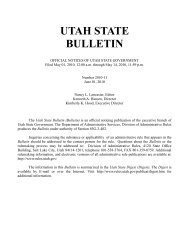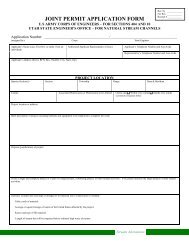Vol. 2007, No. 15 (08/01/2007) PDF - Administrative Rules - Utah.gov
Vol. 2007, No. 15 (08/01/2007) PDF - Administrative Rules - Utah.gov
Vol. 2007, No. 15 (08/01/2007) PDF - Administrative Rules - Utah.gov
Create successful ePaper yourself
Turn your PDF publications into a flip-book with our unique Google optimized e-Paper software.
NOTICES OF PROPOSED RULES DAR File <strong>No</strong>. 3<strong>01</strong>79<br />
62A-2-1<strong>08</strong>.2(4), which requires the program to provide information<br />
to the local <strong>gov</strong>ernment.<br />
(2) A residential treatment program shall comply with this rule<br />
and:<br />
(a) Rule R5<strong>01</strong>-1, General Provisions;<br />
(b) Rule R5<strong>01</strong>-2, Core Standards;<br />
(c) Rule R5<strong>01</strong>-14, Background screening;<br />
(d) state fire prevention laws and rules, including but not<br />
limited to Rule R710-4, Buildings Under the Jurisdiction of the State<br />
Fire Prevention Board, and Rule R710-9, <strong>Rules</strong> Pursuant to the <strong>Utah</strong><br />
Fire Prevention Law; and<br />
(e) all applicable local, state, and federal laws.<br />
(3) At the time of a program's initial application, and annually<br />
thereafter, the program shall provide written verification of<br />
compliance with:<br />
(a) local zoning ordinances;<br />
(b) local business license requirements;<br />
(c) local building codes, as required by the local <strong>gov</strong>ernmental<br />
entity's licensed building inspector;<br />
(d) state fire prevention laws and rules, as determined through<br />
a fire safety inspection by a certified fire safety inspector or fire<br />
marshal; and<br />
(e) state and local health codes.<br />
(4) A program shall comply with Rule R5<strong>01</strong>-16 and obtain an<br />
intermediate secure treatment license prior to offering any<br />
intermediate secure treatment services.<br />
(5) A program shall not exceed the maximum client capacity<br />
indicated on the current license issued by the Office of Licensing.<br />
(6) Each time a program changes the type of client population,<br />
or applies for a license with an increased consumer capacity or for a<br />
new service category, the program shall provide written verification<br />
of local <strong>gov</strong>ernment approval to the Office of Licensing.<br />
R5<strong>01</strong>-19-4. Staff Requirements.<br />
(1) Each owner or member of the <strong>gov</strong>erning body of a program<br />
who makes decisions regarding the program's daily operations shall<br />
successfully complete a minimum of 8 hours of annual training<br />
relating to residential treatment services.<br />
(2) Directors, clinical directors, and acting directors who have<br />
responsibility for the on-site daily administration or operation of the<br />
program shall meet the requirements specified in Subsection R5<strong>01</strong>-<br />
2-11(7) and shall have a minimum of two years of residential<br />
treatment program supervisory experience.<br />
(a) A director or acting director shall be on duty or on call at<br />
all times.<br />
(3) A program shall have a minimum of one staff-in-charge on<br />
duty at all times.<br />
(4) A program providing services to children shall maintain a<br />
minimum direct care staff ratio of one direct care staff on duty for<br />
every six clients, and never fewer than two direct care staff on duty,<br />
between 7:00 a.m. and 9:00 p.m., or during any off site activity.<br />
(a) When more than two direct care staff are required to be on<br />
duty before 9:00 p.m., the additional direct care staff shall not leave<br />
until after all children are asleep.<br />
(b) If clients are awake before 7:00 a.m., the program shall<br />
maintain a minimum direct care staff ratio of one direct care staff on<br />
duty for every six clients, and never fewer than two direct care staff<br />
on duty while clients are awake.<br />
(5) A program providing services to children shall maintain a<br />
minimum direct care staff ratio of one direct care staff on duty for<br />
every twelve clients, and never fewer than two direct care staff on<br />
duty in each building where clients sleep, between 9:00 p.m. and<br />
7:00 a.m.<br />
(6) A program is not required to include a child who is directly<br />
supervised by the child's parent in the staff ratios described in this<br />
section, R5<strong>01</strong>-19-4.<br />
(7) A program providing services to adults only shall maintain<br />
a minimum direct care staff ratio of one direct care staff on duty for<br />
every ten clients, and never fewer than one direct care staff on duty<br />
and one direct care staff on call, between 7:00 a.m. and 11:00 p.m.,<br />
or during any off site activity.<br />
(8) A program providing services to adults only shall maintain<br />
a minimum direct care staff ratio of one direct care staff on duty for<br />
every twenty clients, and never fewer than one direct care staff on<br />
duty in each building where clients sleep and one direct care staff on<br />
call, between 11:00 p.m. and 7:00 a.m.<br />
(9) A substance abuse program providing services to adults<br />
only may reduce the minimum direct care staff ratio in this section if<br />
it has and complies with a written policy and procedures regarding<br />
staff ratios that considers factors particular to its client population,<br />
including but not limited to its clients presenting problems and the<br />
risks they may present to other clients, staff and the community.<br />
(10) A program shall comply with a staffing ratio that is more<br />
restrictive when required by a client's treatment plan or a contract<br />
with the Department of Human Services or its Divisions.<br />
R5<strong>01</strong>-19-5. Documentation.<br />
(1) A program shall maintain a written record for each<br />
individual client, as specified in Section R5<strong>01</strong>-2-6.<br />
(a) Each client written record shall include progress notes<br />
specific to the client's treatment plan, which shall be completed<br />
within one week following each counseling session, describing the<br />
client's behavior, staff interventions, and client responses.<br />
(2) A program shall maintain, and direct care staff shall read, a<br />
daily shift log, which shall include:<br />
(a) a description of the activities and incidents occurring<br />
during each shift;<br />
(b) the date, time, and signature of the staff-in-charge at the<br />
end of each work shift; and<br />
(c) the date, time, and signature of each direct care staff at the<br />
beginning of the staff's work shift.<br />
R5<strong>01</strong>-19-6. Client Services.<br />
(1) A program shall describe how medical services will be<br />
promptly provided.<br />
(a) Upon admission, each client shall be informed of the right<br />
to consult with a medical practitioner and a mental health therapist.<br />
(b) A program that must travel more than 30 miles to an<br />
emergency room or 24-hour urgent care facility shall retain the oncall<br />
services of a medical practitioner and a mental health therapist.<br />
(2) A monthly schedule of activities shall be posted in the<br />
common area and the office. Monthly schedules of activities shall<br />
be filed and retained for a minimum of one year.<br />
R5<strong>01</strong>-19-7. Physical Environment.<br />
(1) The program buildings and grounds shall be maintained in<br />
a safe and clean manner.<br />
(2) Live-in staff shall have a separate living space with a<br />
private bedroom and bathroom.<br />
(3) The program shall have an on-site office or designated<br />
space for records.<br />
52 UTAH STATE BULLETIN, August 1, <strong>2007</strong>, <strong>Vol</strong>. <strong>2007</strong>, <strong>No</strong>. <strong>15</strong>


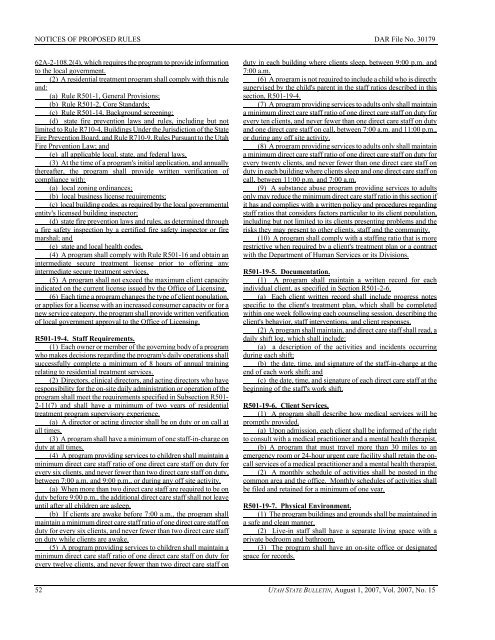


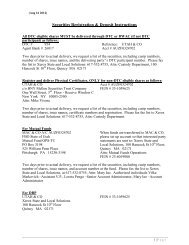
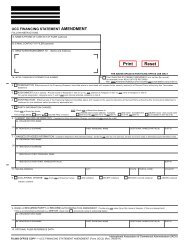
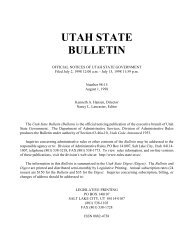
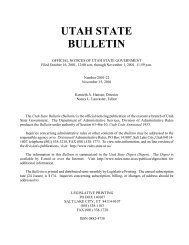



![Lynx avoidance [PDF] - Wisconsin Department of Natural Resources](https://img.yumpu.com/41279089/1/159x260/lynx-avoidance-pdf-wisconsin-department-of-natural-resources.jpg?quality=85)
